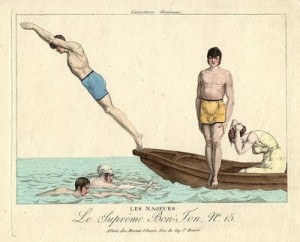According to my fellow blogger, the historical novelist Catherine Delors, eighteenth-century Parisians liked to bathe naked in the Seine, notwithstanding the ‘horrendous pollution’ of the river. Apparently this popular summer pastime was banned after the Revolution, for both men and women. So much for ‘liberté’!
Parisian swimmers reluctantly took to wearing costumes. Catherine reproduces a fascinating print (above) of c.1810-15, from a series called Caricatures parisiennes, in which those of the men are exactly like modern bathing shorts. The women appear to be covered to the knee, apart from their arms, and are wearing caps. For both sexes there is a relatively high exposure of naked flesh, but the prudes of the later nineteenth century would see to that!
Likewise in Britain, the few men and women who had the leisure and inclination to bathe had traditionally done so in the nude, but this was increasingly frowned on. Men and women were still swimming naked together off Weston-super-Mare in the early 1870s, much to the delight of the diarist Francis Kilvert. However, the sexes were increasingly being segregated under local by-laws, as at Shanklin, which Kilvert visited two years later. At such stuffy resorts, nudity was strictly forbidden.
Followers of Catherine’s blog have wondered what Byron would have worn for his epic crossing of the Hellespont that took place at exactly the time of the print (3 May 1810). The poet Shelley, who was a non-swimmer but loved to immerse himself in homage to classical models, always did so naked, ‘just as if he were Adam in Paradise before his fall’. Surprisingly, his future wife, Mary Godwin, strongly disapproved. When, on their way through France, Shelley insisted on stopping to bathe in a stream, she firmly declined to join him, declaring that it would be ‘most indecent’. In Italy, where men, women and children all bathed happily together in the nude, Mary, again, steadfastly refused to take part. To do so, she said, would be ‘improper’. Mary may thus have represented changing attitudes, the trend towards Victorian prudery, notwithstanding that she had been unashamed to elope, at seventeen, with a married man. It is equally possible that she suffered from acute self-consciousness in respect of her own body – unlike her step-sister, Claire Clairmont, whose willingness to bathe naked can only have made her more interesting to the poet.
As for the club-footed Byron, neither his post-swim letter to Henry Drury nor his lines Written After Swimming From Sestos to Abydos includes any reference to his attire. However, Charles Sprawson states in Haunts of the Black Masseur: The Swimmer as Hero (London, 1992), pp.103-4, that Byron ‘always wore trousers to conceal his disfigurement. Only in swimming could he experience complete freedom of movement.’ I do not know on what evidence he bases this assertion, nor whether the poet’s companion, Lieutenant Ekenhead, discarded his drawers for the occasion.
It would be even more interesting to know whether Jane Austen wore anything when bathing off Lyme in 1804: as she writes to her sister, Cassandra, on 14 September – surprisingly late in the year for sea-bathing – ‘The Batheing was so delightful this morning & Molly so pressing with me to enjoy myself that I believe I staid in rather too long …’ (The Letters of Jane Austen, ed. Deirdre Le Faye (Oxford, 1996), p.95).
Read Catherine Delors’s article at http://blog.catherinedelors.com/swimsuits-in-1810-paris/
Grateful acknowledgement is made to Susan Holloway Scott who examines the print at http://twonerdyhistorygirls.blogspot.com/2010/08/men-women-swimming-togetherin-1810.html
